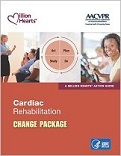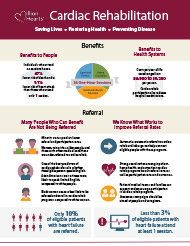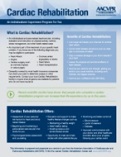Cardiac Rehabilitation
Cardiac rehabilitation, or cardiac rehab, is a comprehensive secondary prevention program designed to improve cardiovascular health following a cardiac event or procedure. An optimal cardiac rehab experience consists of 36 one-hour sessions that include team-based supervised exercise training, education and skills development for heart-healthy living, and counseling on stress and other psychosocial factors (Mayo Clinic Proceedings, 2016). Participation in a cardiac rehab program can reduce the risks of death from any cause and from cardiac causes as well as decrease hospital readmissions. Cardiac rehab participation also improves functional status, quality of life, mood, and medication adherence (Cochrane Database of Systematic Reviews, 2016). Despite these benefits, participation in cardiac rehab remains low, ranging from 19% to 34% in a national analysis (Mayo Clinic Proceedings, 2016), with strong state-by-state geographic variations and differences by cardiac diagnosis. While cardiac rehab services are widely covered by public and private plans, co-pays per session represent a financial obstacle for most participants.
Strong evidence shows that cardiac rehab programs can benefit individuals who have:
- Had a heart attack.
- Stable angina.
- Received a stent or angioplasty.
- Heart failure with reduced ejection fraction.
- Undergone a bypass, valve, or heart or heart-lung transplant surgery.
Improving awareness of its value, increasing referral of eligible patients, and reducing system and patient barriers to participation are all critical steps in improving the referral, enrollment, and participation rates in cardiac rehab programs. Effective remedies have been identified but are not being widely and systematically implemented.
The Million Hearts® Cardiac Rehabilitation Collaborative (CRC) is a national forum for multi-disciplinary professionals who are working to achieve the goal of 70% cardiac rehabilitation participation in eligible patients. The CRC convenes online on a quarterly basis.
To join, email MillionHeartsCRC@cdc.gov with “request to be added to the CRC” in the subject line.
Tools and Resources
For Clinicians and Cardiac Rehab Teams

- Million Hearts®/AACVPR Cardiac Rehabilitation Change Package, 2nd Ed.
This change package is a quality improvement tool to help teams from hospitals and cardiac rehabilitation programs put systems and strategies in place that target improved care for more eligible patients. It presents a listing of process improvements that cardiac rehabilitation champions can implement and includes change concepts, change ideas, and tools and resources.
-
- Million Hearts® partnered with the National Association of Chronic Disease Directors to develop a 4-part video series to provide insights and tips from cardiac rehabilitation champions to implement high impact strategies and/or adapt or adopt featured tools from the Cardiac Rehabilitation Change Package.

Cardiac Rehabilitation At A Glance
This easy-to-scan page highlights key statistics and benefits of the existing cardiac rehabilitation infrastructure. Learn about current challenges as well as strategies needed to maximize uptake of programs in the United States.- View this content in an infographic: Million Hearts® Cardiac Rehabilitation: Saving Lives, Restoring Health, Preventing Disease [PDF – 514K]
- Value-Based Care
This initiative from the American Association of Cardiovascular and Pulmonary Rehabilitation (AACVPR) provides turnkey strategies to improve enrollment and adherence in cardiac rehab programs. - Cardiac Rehab Information for Physicians Webinar Series
This 15-module webinar series provides physicians with information to optimize care for patients who are eligible for or who are participating in cardiac rehabilitation. Dual Continuing Medical Education/Maintenance of Certification (CME/MOC) credit is available. It is available to all at no charge although non-ACC members will need to create an ACC account. - Heart Disease Communications Kit
Use this communications kit to spread awareness about heart disease prevention. Share messages and graphics to help your audiences understand the basics of heart disease, related conditions, ways to reduce risk, and treatment.
For Patients

- Cardiac Rehabilitation [PDF – 399K]
This AACVPR fact sheet provides an overview of cardiac rehab and outlines the benefits to participating in a program. It can also be displayed and distributed in waiting rooms. - Home Health Quality Improvement Cardiac Rehab Video Playlist
This collection of videos, from the American College of Cardiology, the Centers for Medicare & Medicaid Services, and other organizations, covers important information about cardiac rehab, including program basics and what to expect from participating in a cardiac rehab program. Additionally, these videos include stories and experiences from patients who participated in cardiac rehab programs. - American Heart Association: Cardiac Rehab
This collection of materials from the American Heart Association provides patients with details about what cardiac rehab offers, its benefits, eligibility guidance, common questions and answers, and what can be expected from the experience.
For Partners
- Million Hearts® Cardiac Rehabilitation Slide Deck: Getting to 70% Cardiac Rehabilitation Participation [PPT – 28 MB]
This communication tool contains slides and talking points for partners to communicate the value of CR, estimated CR participation rates, persistent disparities in participation, barriers to uptake, and opportunities to increase CR participation in support of achieving the Million Hearts® target of 70% CR participation among those eligible. - Million Hearts® Outpatient Cardiac Rehabilitation Use Surveillance Methodology (2025) [PDF – 1 MB]
Provides an administrative claims-based outpatient cardiac rehabilitation surveillance methodology that can be applied to member databases within health insurance plans and health system databases to monitor and inform cardiac rehabilitation-related quality improvement efforts. - Using CDC’s Interactive Atlas of Heart Disease and Stroke to Access Cardiac Rehabilitation Data [PDF – 3 MB]
This resource explains how to use CDC’s Interactive Atlas of Heart Disease and Stroke to create maps with relevant data to help improve access to CR and assess CR referral, enrollment, participation, and completion rates. - Improving Health and Employment Outcomes for Employees with Heart Disease: The Value of Cardiac Rehabilitation [PDF – 316 KB]
This factsheet describes the burden of heart disease among working adults, the value of cardiac rehabilitation on improving employee health and employment outcomes, and actions that occupational health teams can take to increase enrollment in cardiac rehabilitation among workers. - Cardiac Rehabilitation Communications Toolkit
This communications toolkit will equip your organization with resources and messages to spread awareness about the value of cardiac rehabilitation and solutions for increasing participation.
References and Key Publications
Featured Resource
- Increasing Cardiac Rehabilitation Participation From 20% to 70%: A Road Map from the Million Hearts® Cardiac Rehabilitation Collaborative
The Million Hearts® Cardiac Rehab Collaborative road map outlines the key action steps and best practices to increase cardiac rehab participation rates from 20% to 70%. (Mayo Clinic Proceedings, 2016)
- Tracking Cardiac Rehabilitation Utilization in Medicare Beneficiaries: 2017 Update
This article found absolute enrollment, engagement, and program completion rates remain low among Medicare beneficiaries indicating that many patients did not benefit or fully benefit from guideline-recommended therapy. - Million Hearts® Cardiac Rehabilitation Think Tank: Accelerating New Care Models
This article describes the proceedings from the October 2020 Million Hearts® Cardiac Rehabilitation Think Tank and explores terminology, core components, policy, equity, implementation, and research considerations for broad uptake of new CR care models. - 2018 ACC/AHA Clinical Performance and Quality Measure for Cardiac Rehabilitation
This article provides updated recommendations for the cardiac rehabilitation quality measures. New measures include: inpatient/outpatient referrals for exercise training for heart failure, assessment of enrollment, adherence, and cardiac rehabilitation communication. - Exercise-Based Cardiac Rehabilitation for Coronary Heart Disease: A Meta-Analysis
This review confirms that participation in exercise-based CR by patients with coronary heart disease receiving contemporary medical management reduces cardiovascular mortality, recurrent cardiac events, and hospitalizations, and provides additional evidence supporting the improvement in health-related quality of life and the cost-effectiveness of CR. - 2022 AHA/ACC/HFSA Guideline for the Management of Heart Failure: A Report of the American College of Cardiology/American Heart Association Joint Committee on Clinical Practice Guidelines
Exercise training is recommended for patients with heart failure who are able to participate (class Ia recommendation) and cardiac rehabilitation can be useful in improving functional capacity, exercise tolerance, and health-related quality of life for patients with heart failure (class IIa recommendation). - Use of Outpatient Cardiac Rehabilitation Utilization Among Heart Attack Survivors — 20 States and the District of Columbia, 2013 and Four States, 2015
Data from 20 U.S. states and the District of Columbia indicate that only 1 in 3 heart attack survivors reports receiving cardiac rehab after suffering a heart attack. - AACVPR/AACF/AHA 2010 Update: Performance Measures on Cardiac Rehabilitation for Referral to Cardiac Rehabilitation/Secondary Prevention Services
This document updates two measures that articulate the opportunities to improve referrals to cardiac rehabilitation: Cardiac Rehabilitation Patient Referral from an Inpatient Setting and Cardiac Rehabilitation Patient Referral from an Outpatient Setting. These revisions help to clarify several aspects of the measures and to facilitate their implementation, which will provide clinicians and institutions with an opportunity to measure the quality of care and identify opportunities for improvement.

